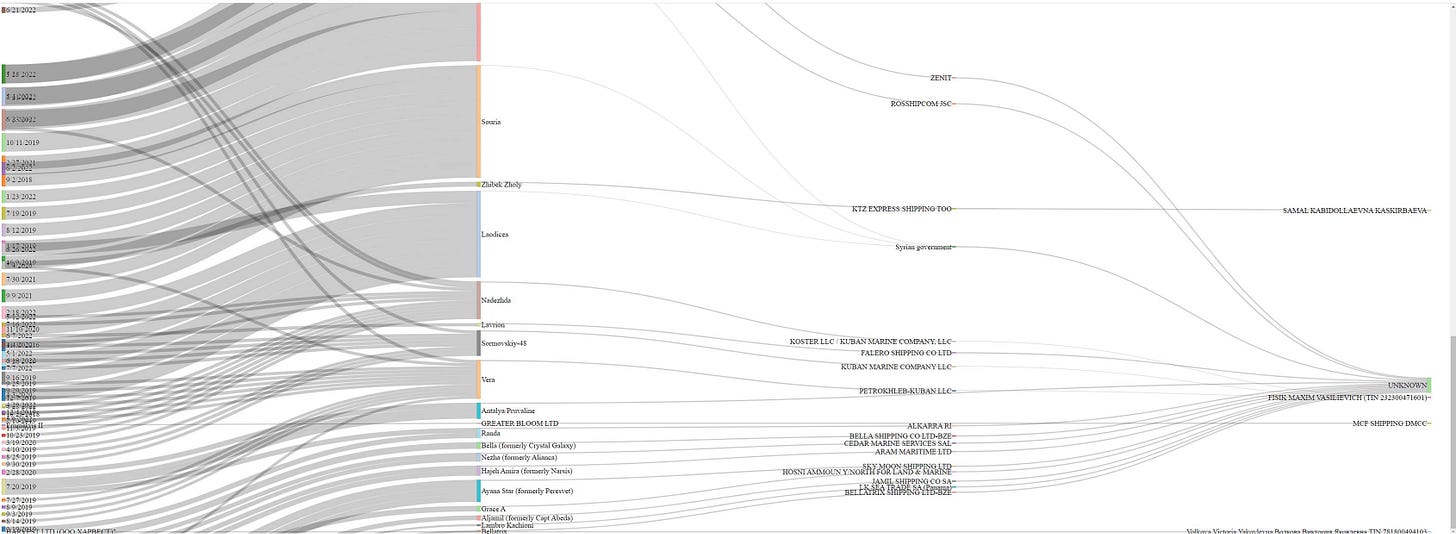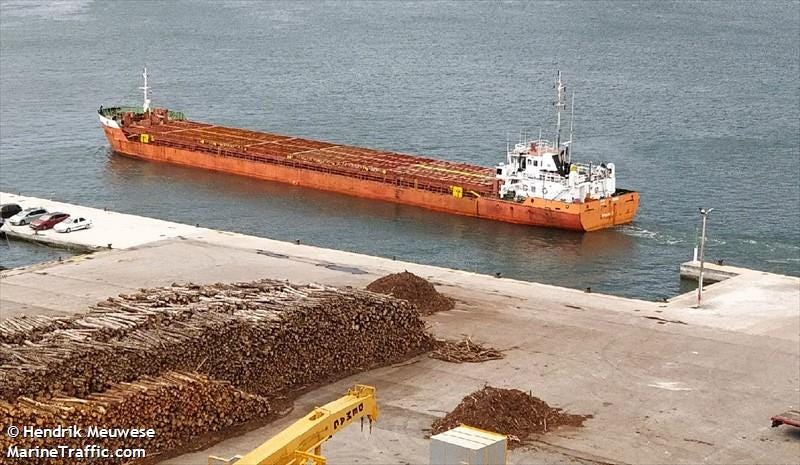So, election targeting is at the top of my mind right now. I'm going to be head-down making a slide deck from a data visualization to support sanctions designations against a series of Russian nationals involved in the contraband grain trade in Ukraine (hey, that rhymes).
I'll be posting slides to my Patreon & Substack subscribers first; I'm just about in a place where I can do that without breaking everything.
What I have is essentially a dashboard for monitoring expropriation of grain; I ignore other smuggled commodities like ilmenite, coal or steel due to the current focus on international famine exacerbated by the Ukraine war.
This is going to look a lot different (that's today's work) but what you're looking at shows, from left to right:
individual shipments of expropriated, stolen or just plain smuggled grain products from Ukraine since 2016 ; the height of each bar corresponds to shipment volume
the ships that ran each shipment; the height of each bar corresponds to the total volume that they've shipped
the companies that own the ships
the owners of the companies that own the ships
The goal here isn't just finding some (pardon me) dinky little "rusty wreck with starvation wages" like the NADEZHDA (IMO 8611221, MMSI 273456690, callsign UBXS8, flag Russia, gross tonnage 1,984, deadweight tonnage 3,217). It's finding the owners, and showing how many shipments and how much grain each owner is responsible for.
So, in this case, the NADEZHDA's owner is KOSTER LLC / KUBAN MARINE COMPANY, LLC, their owner is FISIK MAXIM VASILIEVICH, his Russian taxpayer identification number is 232300471601, his address is "Krasnodar Territory, Abinsk District, city of Abinsk".
A job listing dated July 10, 2022, archived here, suggests an address of Ulitsa Severnaya, 326, Krasnodar, Krasnodarskiy kray, Russia, 350000, grid 45.04040079173095, 38.970789288367655, which does not correspond to other addresses for KOSTER or KUBAN.
Also, wow, that job looks terrible.
There's a way to show this all in a way that makes sense. This is the task of reusable data visualizations - a way of graphing the data that will "automatically" change when the data changes, so you don't need to remake it every time something happens.
The basic problem that I'm trying to solve for "users" - defined here as people at government agencies and journalists whom I show this to, primarily, secondarily myself and my audience - is picking out, at a glance, the most critical facet of what's going on here, and having assurances that the data underlying its view are good.
The process is slightly unwieldy, but I'm getting good feedback that it solves the problems that my critical users really want solved, so that's fine; I can solve scaling problems later or leave them to engineers to solve if this is a process that people want to expand.
But the immediate next thing on deck for me is political activism. The opportunity that I have is unique: as a community-supported activist specializing in direct action through earned media, I can basically choose whatever I want to work on. As long as my "base" agrees with me that it's important, I have support. The basic problem as I see it is that everything is on the table right now because of the extreme elements of the Republican party; the list of stakes - everything from reproductive rights to Ukraine aid - is slightly obvious. Hell, these sanctions designation requests aren't going to matter a whole lot if the political climate shifts and Congress starts inserting investigations and subcommittees and general partisan stupidity into our Ukraine policy.
The way the stakes interplay is less obvious. So, there's one side that sees what's happening with the extremist right as a boon to Democratic candidates looking at '22.
There's a lot to unpack and critique here in terms of conventional and rather problematic views onto politics (this is Cook Political Report, so...) but there's other evidence that the extremity of the stakes has Democratic Party assets supporting extremist-right candidates that they think they can beat (here's the Times on it).
Looking at this environment, the game is tactical, local, and highly selective, for an activist given freedom of action and targeting, I think. A simple nationally uniform message isn't going to fly as well as it did during the Trump years; the kinds of narratives that you use against, say, a high-profile moron like Boebs or Taylor-Greene is going to play differently against a rank-and-file Republican trying to just keep their heads down and stay under the national radar. Those kinds of moderates are, indeed, enough of a threat that the DNCC is backing Republican extremists against them... so that also means that standard counter-extremist narratives might not work either, not in races that don't have an extremist in them.
The flipside of that though, is that there's the possibility of finding convergences, or identifying places where national narratives about extremism and local politics might coincide in a way that works.
So, I have a decent amount of background research at this point that's still somewhat good, that suggests Nevada's 1st & 3rd Congressional districts and Nevada's Senate race overlap in interesting ways - if you address one county, Clark County, in which, like, 80% of Nevada lives, you're basically affecting two Congressional seats, one of which is in flux, as well as a Senate race.
I'm wary of going off of post-dated intel, though.
I mean, Pennsylvania, and this cat?
There's a lot to work with there. I mean, just... salad days, with the memes, folks, that's what we'd be looking at. He's down by nine points in the most recent polling that 538 shows, though, so maybe nature just runs its course here, as it were.
Anyway.





